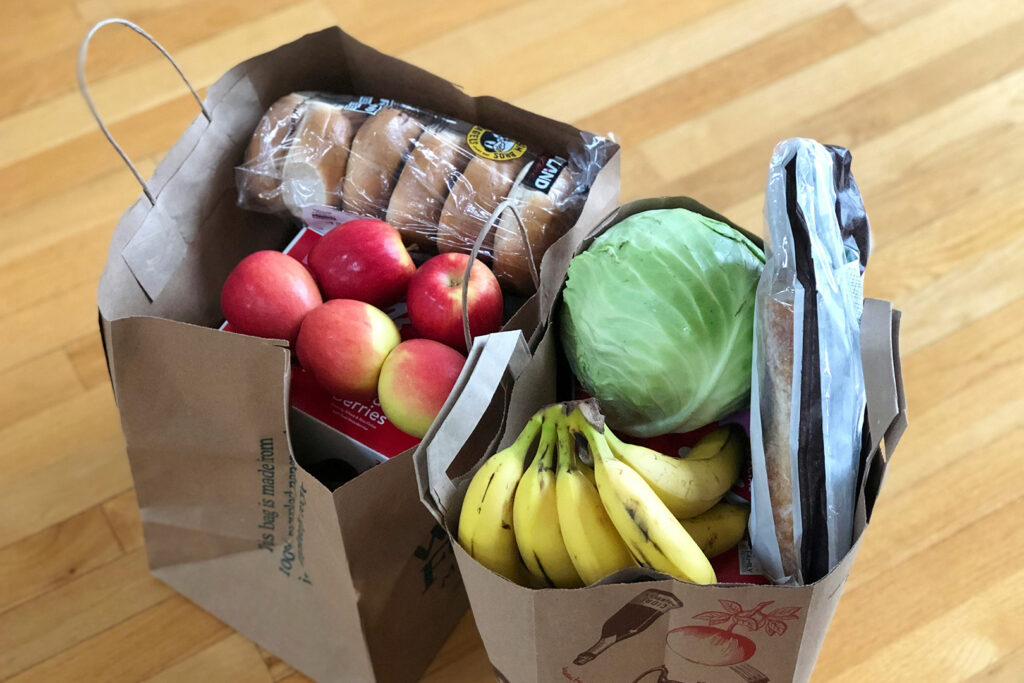
If you are in charge of planning meals for your family, grocery shopping can be quite the overwhelming experience. Besides the rising cost of buying groceries, there are also so many bad ingredients and unhealthy options to choose from. Learning how to avoid harmful ingredients in food can seem like a daunting task.
Whether you’re single and just shopping for yourself or a mom trying to provide food for your family, you probably don’t have tons of free time to educate yourself on unhealthy ingredients. If you have the desire to choose the best groceries for your health but don’t want to spend hours researching, this post is for you!
The healthiest way to eat is to avoid processed foods as much as possible. Opt for meats, fruits, and veggies over processed foods like cereal, fruit and granola bars, etc. There is still some things to watch out for when buying meats, veggies, and fruits.
When buying produce or meats, look for the Organic seal. This seal means that the U.S. Department of Agriculture (USDA) certifies that there are no chemical fertilizers, pesticides, herbicides, hormones, drugs, or GMOs (genetically modified ingredients). When a label says “100% organic, then the entire product is organic. If it just says “organic”, then it’s at least 95% organic.
When a label says “natural”, that term doesn’t mean the same as organic. USDA controls this phrase for meat, poultry, and eggs, but not for anything else. In many cases, the term means nothing. But even for meat poultry, and eggs, it doesn’t speak to the farm practices used to create the products. Organic is a better label than natural.
Genetically modified organisms, or GMOs, can be bad for your health. GMO foods have had their DNA altered using genetic engineering techniques. GMOs are believed to be toxic for our organs and they could be linked to cancer and other health problems. Common GMO ingredients in foods include soybean oil, canola oil, soy flour, corn syrup, corn meal, corn starch, sucrose, soy lecithin, and vegetable protein.
When selecting beef, look for grass-fed beef. Grass is the natural diet of cows, but many big producers, feed them grains to fatten them up. This unnatural diet, paired with the fact that grain-fed cows are typically kept in poor living conditions, leads to sickly cows that are often treated with antibiotics. These antibiotics end up in the meat that we eat. Grass-fed cows are healthier and have better lives because they are allowed to roam and live naturally. In addition to being anti-biotic free, grass-fed beef is nutritionally richer.
An important term to look for is grass-finished beef. Sometimes, the beef is fed a diet of grass and then they are fed grain in the last part of their lives to help them gain weight. Grass-finished indicates that the cow were only ever fed grass.
When buying poultry, you’ll want to look for labels that have a couple of important claims.
When purchasing poultry, avoid labels that read “vegetarian fed.” While this is slapped onto product to make them appear healthy, the natural diet of chickens is actually omnivorous, meaning they eat both vegetables and meat.
When buying eggs, you’ll see some of the same terminology used as when buying chicken. Cage free means the birds aren’t kept in cages, but they are often still jammed into small spaces. Free range means they have access to the outside, but doesn’t specify how large the area is. Pasture-raised means that the chickens were allowed to roam freely and have a natural diet.
If you choose to eat processed foods, you really need to read the ingredient labels carefully to ensure that you are only eating healthy ingredients.
In general, you’ll want to avoid the following ingredients:
If you’re interested in learning why these ingredients are bad for you, check out this article about ingredients to avoid on food nutrition labels.
If you must shop for processed foods, look for foods that have a low amount of total ingredients – the fewer ingredients the better! And be sure to avoid the list of no-no ingredients. Also, look for processed foods that are low in sugar. Snacks are considered low sugar if they have less than 5% of your daily value of added sugar.
If you have time to prepare foods yourself, you may find that baking certain items yourself, such as breads, granola bars, fruit bars, or even cheese and almond milk can give you control over exactly what you are eating. If you find your organic processed foods are getting too pricey, consider finding a good recipe on Pinterest and making it yourself!
I personally have stopped buying bread and instead make it myself. It’s cheaper and saves money! I also make homemade oatmeal chocolate chip bars and homemade fruit bars. I like having control of the ingredients I choose to feed my family! Check out my Pinterest board for a collection of fun recipes to try.
If you are looking for an easy resources on how to avoid harmful ingredients in food, you can bookmark this post to keep as a reference. Be sure to check out our handy printable PDF which summarizes the content from this post in a short checklist format.
For help on the go while you are grocery shopping, check out the app Bobby Approved. This free app helps you determine whether a food is healthy or not. This free app allows you to easily scan barcodes and get the information you need about the foods you are selecting and will teach you how to avoid harmful ingredients.
https://www.peacehealth.org/medical-topics/id/abo6495
https://sevensons.net/grass-fed-vs-grain-fed
https://www.smartchicken.com/9-things-to-consider-when-buying-chicken
https://www.nongmoproject.org/gmo-facts/ https://verdefarms.com/recipe/what-is-the-difference-between-grass-fed-and-grass-finished-beef/https://www.consumerreports.org/overuse-of-antibiotics/what-no-antibiotic-claims-really-mean
https://www.consumerreports.org/overuse-of-antibiotics/what-no-antibiotic-claims-really-mean
https://www.karlfamilyfarms.com/blogs/news/what-does-no-added-hormones-mean
https://blog.whiteoakpastures.com/blog/free-range-vs-pasture-raised-difference
https://realfoodbar.com/blog/ingredients-to-avoid-on-food-nutrition-labels

